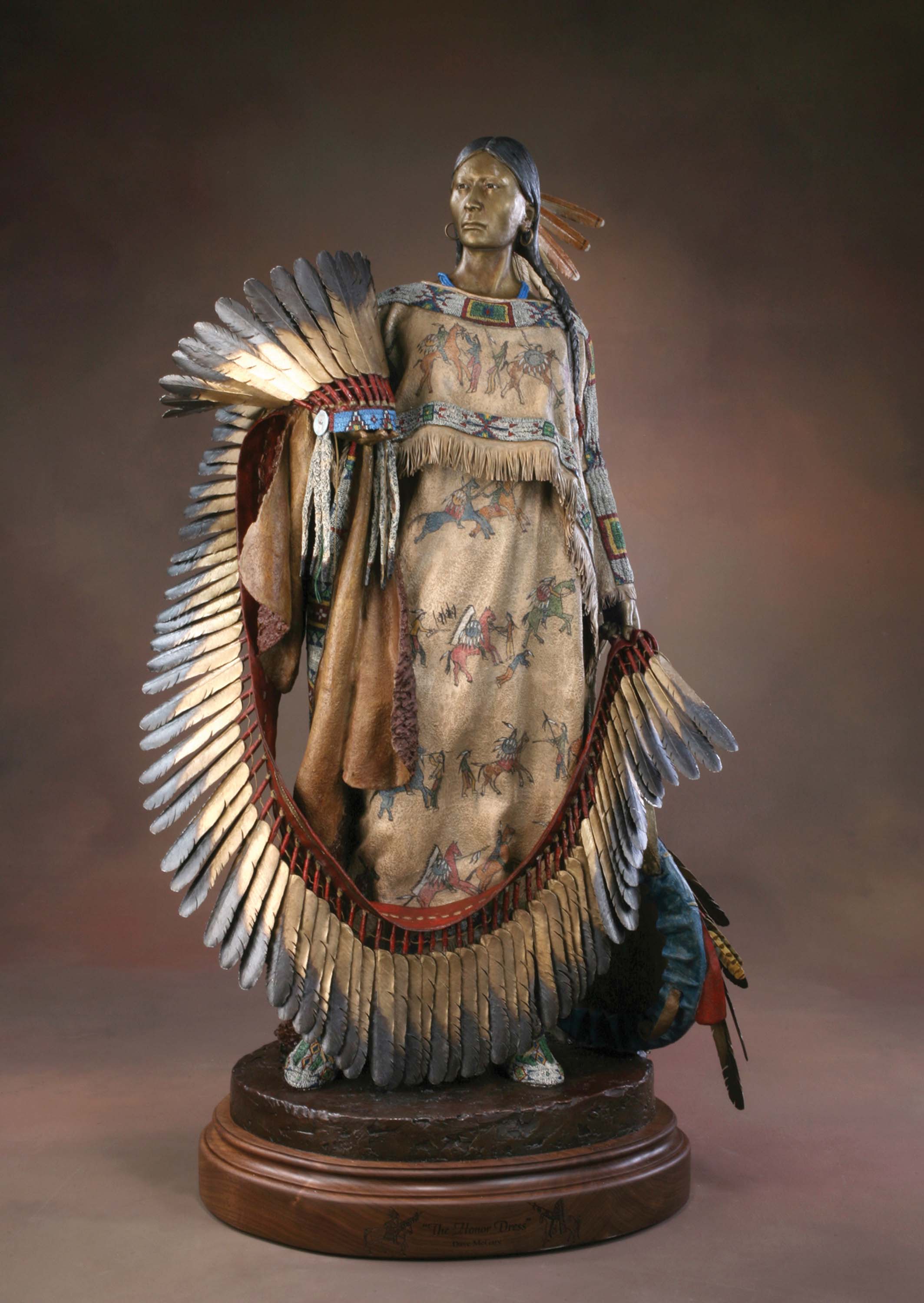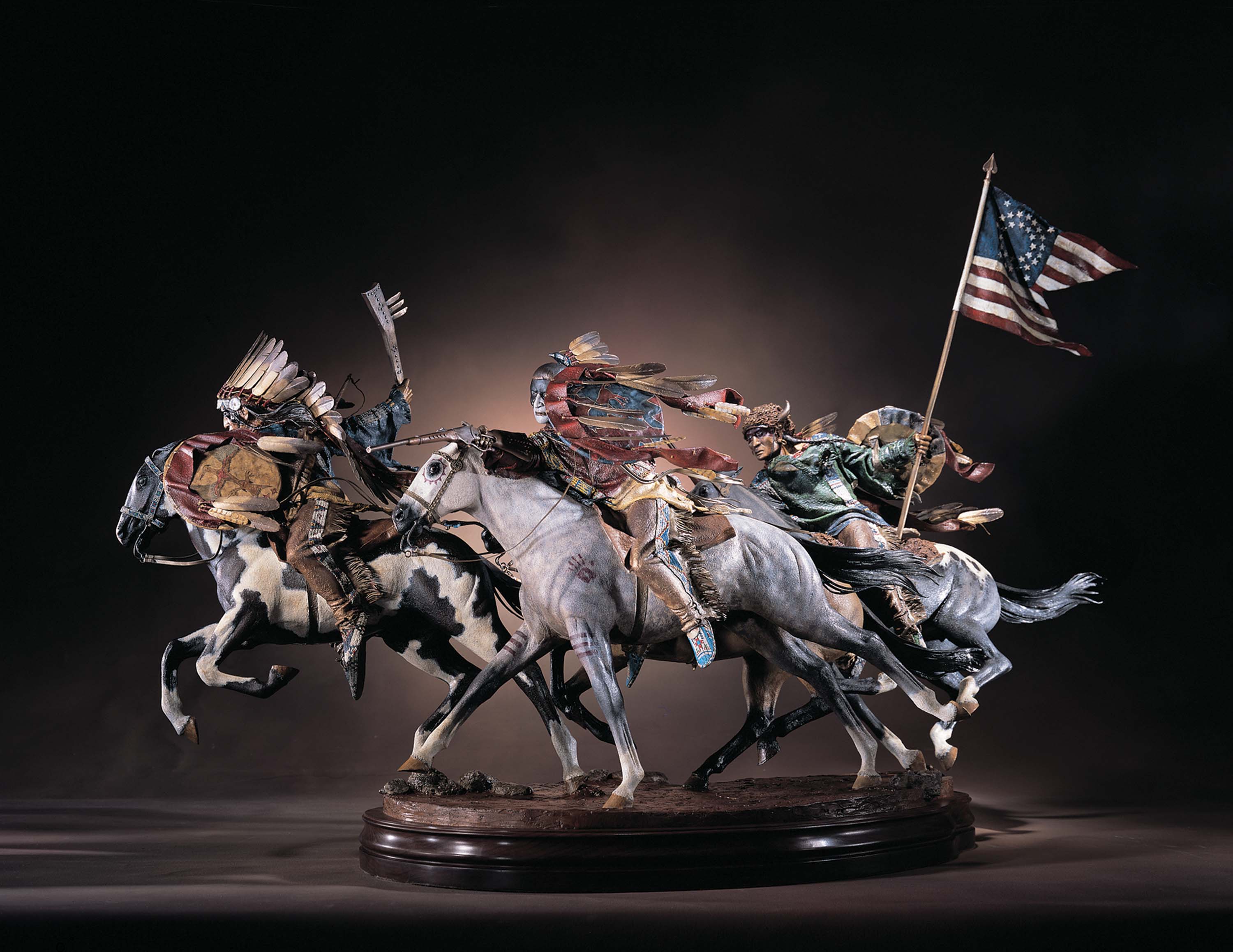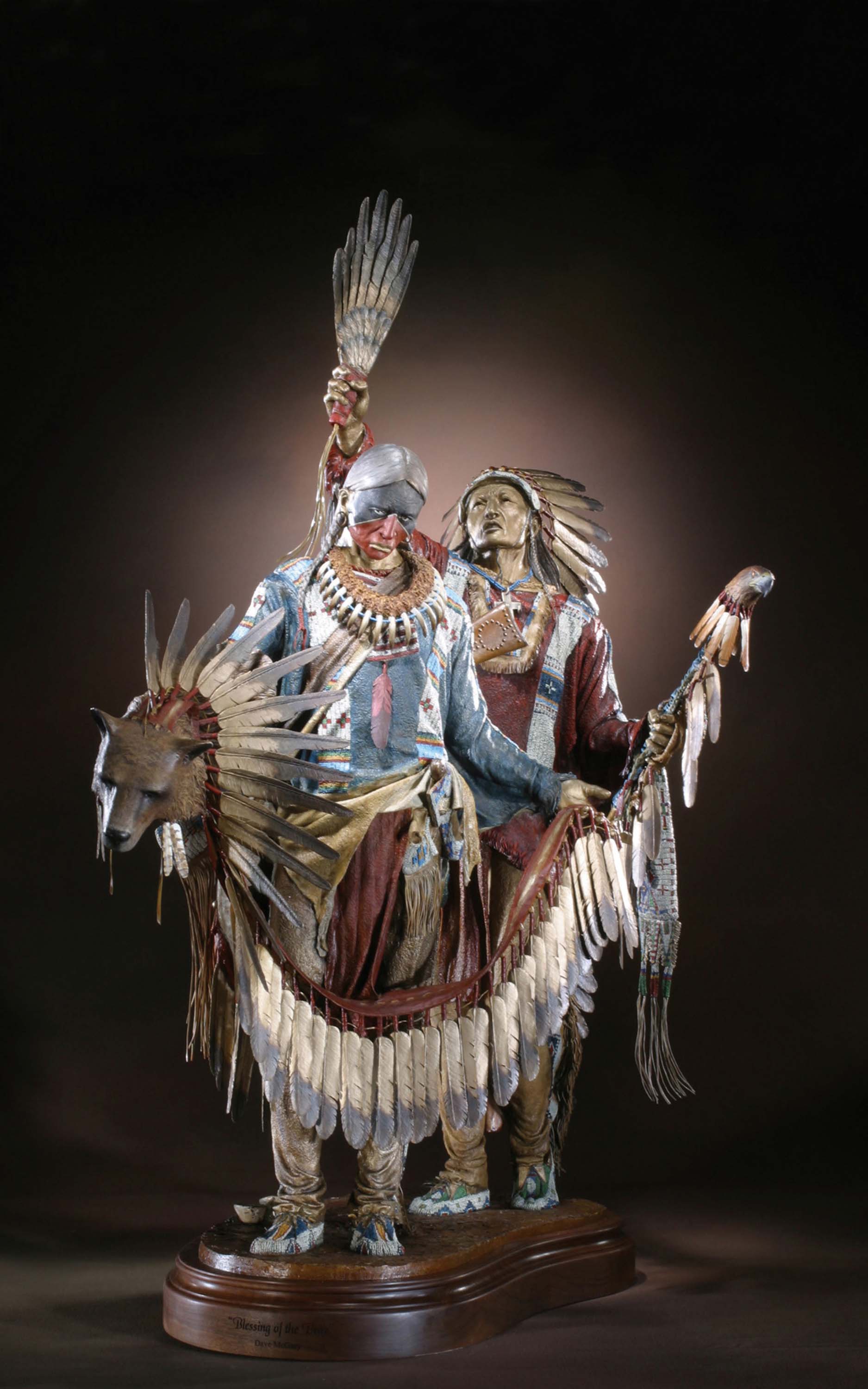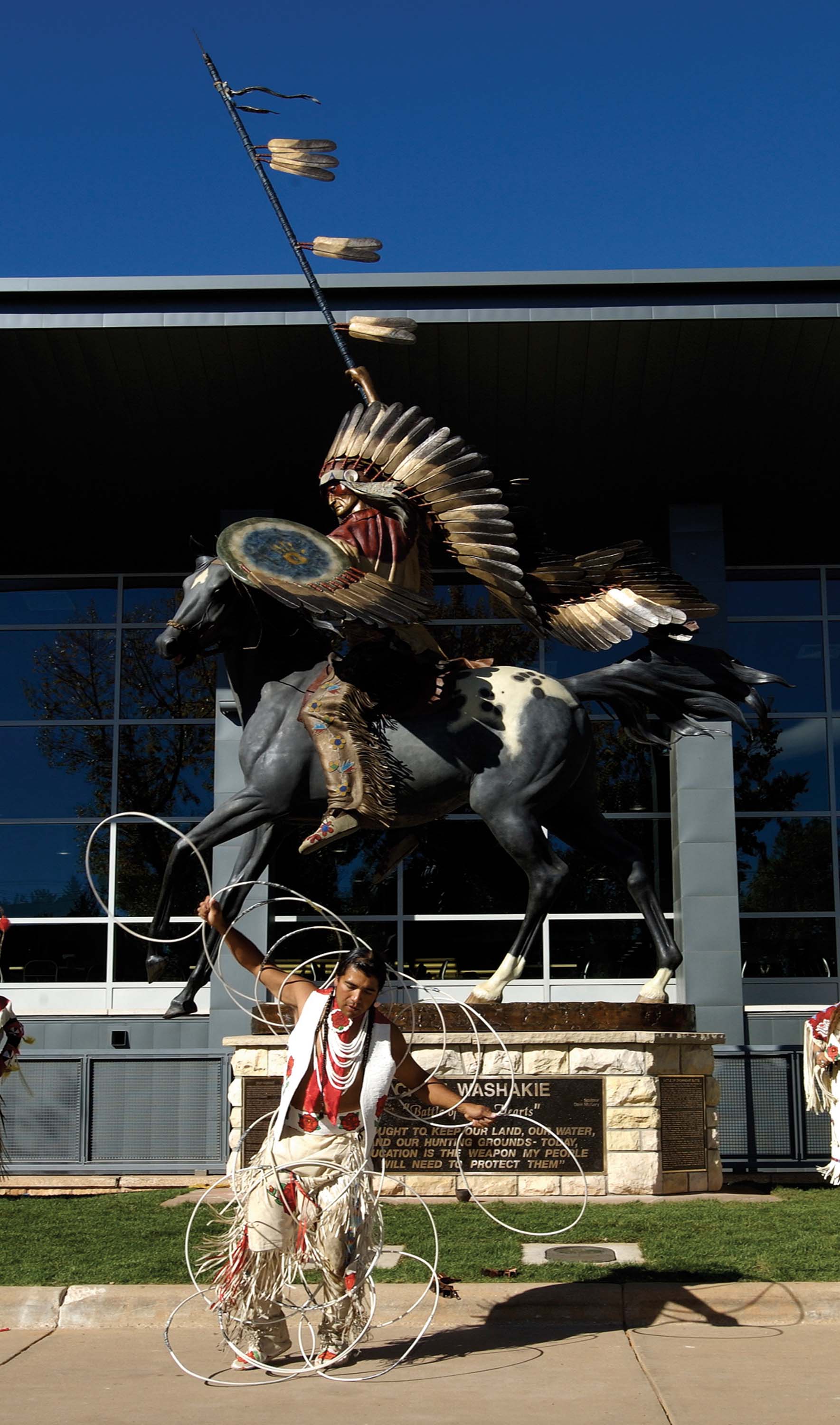
01 Feb The Beating Heart of Bronze
DAVE MCGARY'S SCULPTURES DO NOT HAVE A HEARTBEAT.
They do not draw breath. They are bronze, not flesh and bone. Although it’s difficult to be sure because of the staggering realism that he incorporates into his creations. McGary sculpts proud, historically authentic Native Americans. Sizes range from tabletop busts to large-scale monuments, yet all share the same unexpected depths of textures and splashes of color that defy the essence of the medium.
The sculptures are entirely bronze. They are not adorned with accoutrements, despite what a first glance leads you to believe. The beaded fabric, rumpled leather clothing and feathered headdresses are bronze. Those slender strips of fringe and impossibly wispy feathers don’t rustle in the breeze. Run your fingers over the intricate beading, the folds of the material and you feel only the coolness of metal.
But don’t blame failing eyesight for the uncertainty. Considered the Master of Realism, Dave McGary has been conjuring up vivid and thought-provoking historic figures for more than three decades. His exquisite depictions of Native Americans occupy places of honor in an array of prestigious settings, including the Smithsonian Museum, the U.S. Capitol National Statuary Hall, the Eiteljorg Museum of American Indians and Western Art, the Houston Astrodome, the Buffalo Bill Historical Center and many more. His exhibition at the Booth Western Art Museum will be on display from March 7 through June 30.
McGary grew up on a ranch in Cody, Wyoming. At about the time in life when most kids struggle to cope with the rigors of a paper route, he landed a more challenging part-time job. At 16, McGary was learning to cast bronze from master craftsmen halfway around the world.
McGary was one of four people in the United States given a grant to study casting techniques in Italy. He credits that opportunity in providing him with the strong foundation and self-assurance to stretch the boundaries of his art.
“That was my formal training,” says McGary. “Not only casting but anatomy and sculpting techniques. To learn how to cast bronze from seventh-, eighth-and ninth-generation craftsmen whose grandfather’s grandfather’s grandfather cast pieces in the cathedrals of Rome was an amazing experience.
That’s why I have ‘There Are No Limits’ signs posted around. I sculpt whatever I want to sculpt, not thinking ‘that might be too thin’ or ‘that might not work.’ I know I can cast it. That’s what the Italians gave me, that confidence.”
With one life altering experience under his belt, McGary embarked on another. Soon after returning to the United States as an 18-year-old with an impressive skill set, he took a job at a Santa Fe foundry. While there he made friends with Native American students who were attending the Institute of American Indian Arts. Those relationships introduced McGary to Sioux Indian families, including tribal historian Gerald Red Elk. A bond was formed over time and McGary absorbed the stories and knowledge Red Elk shared. He was eventually adopted into that tribe’s Bear Clan and frequently attended ceremonies where no English was spoken and he was the only white person in attendance.
“The Native American community is so involved with what I do. They see me as kind of a messenger,” says McGary. “They know I can teach with my work and document their culture and history the correct way. Those ties are really the passion and oxygen that fuel my work.”
Learning about Native American life, present and past, also defined McGary’s artistic vision. It gave him a subject matter that he was enthusiastic about and also pushed him to redefine the limits of his medium. Because of the lavish detail included in the composition, as many as 160 separate castings of feathers, fringe, guns and regalia are required for each bronze. And then there’s the addition of color that truly sets McGary’s sculptures apart.
“Color is my signature. I started doing it probably 25 years ago,” says McGary. “At the time I was sculpting bronzes and putting the same old shoe polish brown patina on it that everybody told me to use. But I’m watching these incredible ceremonies and they’re so colorful. Faces are painted, shirts are painted and I knew I had to incorporate color somehow.”
McGary utilizes a combination of patinas to bring out the richness of the bronze and paint to enhance the detail, all done in multiple time-consuming steps. The patina process consists of heating small sections of the bronze and applying chemicals that speed up oxidation, creating shades of color.
The vibrant acrylic paints are the crowning touch, that final element infusing each piece with a level of devastating realism. McGary developed techniques that add stable, precision color to the bronze. Beads are painted one by one. Dazzling designs on jackets, blankets and shields are painstakingly painted, creating artistic tableaus within the larger art piece.
Color so expertly applied is the game changer. It kicks the door down to the past and snatches you from the quiet museum or gallery. For an instant, you are on the Northern Plains amid the perfume of woodsmoke and rained-on sage, the music of horses cropping sweetgrass. For a heartbeat, you are pulled into the story.
Mindful of the trust he’s been given, McGary makes every effort to give back to the community. The Washakie Foundation, started by McGary, his wife Molly and close friend James Trosper, the great-great-grandson of legendary Chief Washakie, is one of his charitable organizations. For every tabletop edition of Battle of Two Hearts sold, a percent-age of the sales go to fund Native American scholarships to the University of Wyoming.
The exhibition of McGary’s work at the Booth Western Art Museum in Cartersville, Georgia, will present a complete retrospective of his work. More than 30 bronzes on loan from private collections will be on display, including some of his earliest all the way through his most-recent pieces.
“We believe Dave McGary’s work combines a unique mix of Western history, attention to detail, raw emotion and contemporary flair,” says Seth Hopkins, executive director of the Booth.
“Dave’s style, combining the use of both patina and paint to give his bronze sculpture vivid realism, similar to photo-realist paintings, has sparked debate among collectors and critics throughout his career. We look forward to bringing this discussion into the museum setting by hosting this exhibition and inviting Dave to lecture at the Booth. We have found great support for the exhibition among collectors of Dave’s work in the Southeast, many of whom are generously loaning pieces for the exhibition.”
The Booth, an affiliate of the Smithsonian Institution, hosts eight to 10 temporary exhibitions per year. Several exhibitions focus the spotlight on individual artists the museum believes to be leaders in moving contemporary Western art forward. McGary will be the first sculptor included in this series.
“This is a great opportunity to exhibit my work in one of the premier museums in the country and to let everyone experience the First Americans through my sculpture,” says McGary.
Currently, McGary is working on a series on the 18th-century tribes of the Eastern woodlands.
“I’ve always been interested. Their heads are shaved; they wear earrings and carry long rifles. Their bodies are painted. It’s perfect for me.” says McGary. “So I’m learning more about the history and some of the key chiefs and warriors in those societies. Once I do that I’ll start the series.”
And no doubt form many new friendships along the way.
With one life altering experience under his belt, McGary embarked on another. Soon after returning to the United States as an 18-year-old with an impressive skill set, he took a job at a Santa Fe foundry. While there he made friends with Native American students who were attending the Institute of American Indian Arts. Those relationships introduced McGary to Sioux Indian families, including tribal historian Gerald Red Elk. A bond was formed over time and McGary absorbed the stories and knowledge Red Elk shared. He was eventually adopted into that tribe’s Bear Clan and frequently attended ceremonies where no English was spoken and he was the only white person in attendance.
“The Native American community is so involved with what I do. They see me as kind of a messenger,” says McGary. “They know I can teach with my work and document their culture and history the correct way. Those ties are really the passion and oxygen that fuel my work.”
Learning about Native American life, present and past, also defined McGary’s artistic vision. It gave him a subject matter that he was enthusiastic about and also pushed him to redefine the limits of his medium. Because of the lavish detail included in the composition, as many as 160 separate castings of feathers, fringe, guns and regalia are required for each bronze. And then there’s the addition of color that truly sets McGary’s sculptures apart.
“Color is my signature. I started doing it probably 25 years ago,” says McGary. “At the time I was sculpting bronzes and putting the same old shoe polish brown patina on it that everybody told me to use. But I’m watching these incredible ceremonies and they’re so colorful. Faces are painted, shirts are painted and I knew I had to incorporate color somehow.”
McGary utilizes a combination of patinas to bring out the richness of the bronze and paint to enhance the detail, all done in multiple time-consuming steps. The patina process consists of heating small sections of the bronze and applying chemicals that speed up oxidation, creating shades of color.
The vibrant acrylic paints are the crowning touch, that final element infusing each piece with a level of devastating realism. McGary developed techniques that add stable, precision color to the bronze. Beads are painted one by one. Dazzling designs on jackets, blankets and shields are painstakingly painted, creating artistic tableaus within the larger art piece.
Color so expertly applied is the game changer. It kicks the door down to the past and snatches you from the quiet museum or gallery. For an instant, you are on the Northern Plains amid the perfume of woodsmoke and rained-on sage, the music of horses cropping sweetgrass. For a heartbeat, you are pulled into the story.
- “The Honor Dress” | Bronze with Patina and Paint | 33 x 20 x 17 inches
- “Last Stand Hill” | Bronze with Patina and Paint | 36 x 53 x 22 inches
- “Blessing of the Bear” | Bronze with Patina and Paint | 41 x 28 x 28 inches
- A hoop dance performance in front of “Battle of Two Hearts” (standing over 30 feet tall) at the University of Wyoming Washakie Center. (Click to expand image.)










No Comments